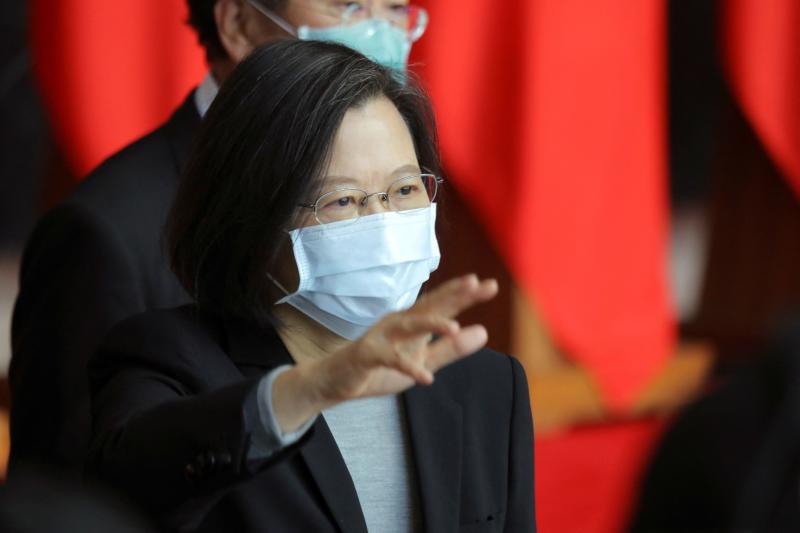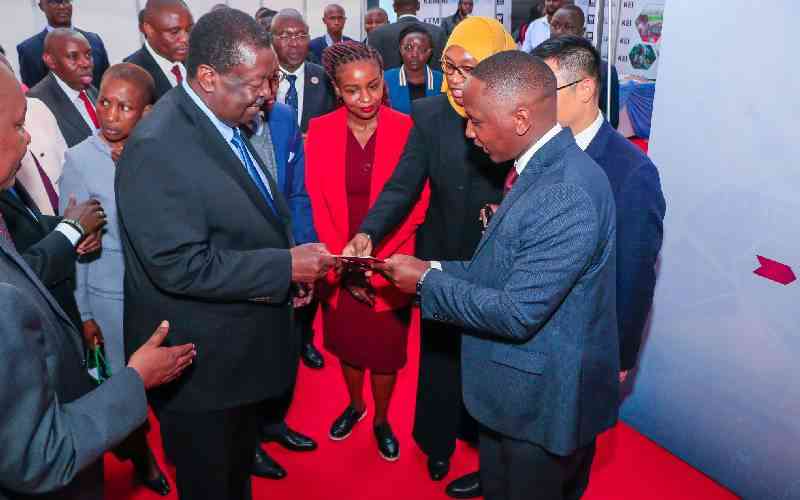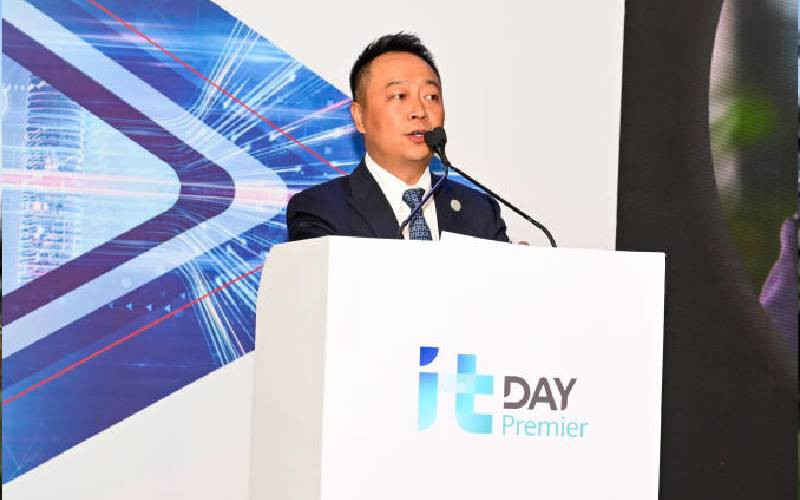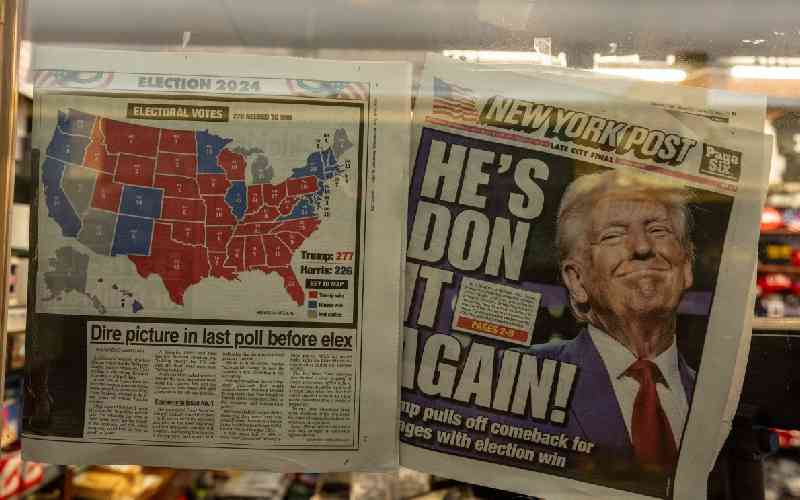
On the front line of the superpower struggle between the United States and China, Taiwan has fashioned a defensive masterstroke. It has become indispensable to both sides.
In dominating the fabrication of the most advanced semiconductors, the giant Taiwan Semiconductor Manufacturing Company Ltd (TSMC) has captured a technology that’s crucial to the cutting-edge digital devices and weapons of today and tomorrow. TSMC accounts for more than 90 per cent of global output of these chips, according to industry estimates.
Both superpowers now find themselves deeply dependent on the small island at the centre of their increasingly tense rivalry.
For Washington, allowing an increasingly powerful China to overrun TSMC’s foundries in a conflict would threaten US military and technological leadership. However, if Beijing invades, there is no guarantee it could seize the prized foundries intact. They could easily become a casualty of the fighting, severing the supply of chips to China’s vast electronics industry. Even if the foundries survived a Chinese takeover, they would almost certainly be cut off from a global supply chain essential to their output.
Both America and China want to break their dependency. Washington has persuaded TSMC to open a US foundry that will make advanced semiconductors and is preparing to spend billions rebuilding its domestic chip-making industry. Beijing, too, is spending big, but its chip industry lags a decade or so behind Taiwan’s in many key areas. Analysts say that gap is expected to widen in the years ahead.
So valuable are these foundries to the global economy that some refer to Taiwan’s chip sector as a “silicon shield” that deters a Chinese attack and ensures American support.
In an interview, Taiwan Economy Minister Wang Mei-hua told Reuters in September that the industry is deeply intertwined with the island’s future.
“This isn’t just about our economic safety,” she said. “It appears to be connected to our national security, too.”
In a later statement, the ministry played down the silicon-shield theory. “Rather than saying that the chip industry is Taiwan’s ‘Silicon Shield,’” the statement said, “it is more appropriate to say that Taiwan has an important position in the global supply chain.”
The danger for Taiwan is that TSMC’s fabs, as the chip fabrication plants are known, are right in the line of fire.
The foundries are located on the narrow plain along Taiwan’s west coast facing China, some 130 kilometres away at the nearest point. Most are close to so-called red beaches, considered by military strategists as likely landing sites for a Chinese invasion. TSMC’s headquarters and surrounding cluster of fabs at Hsinchu in northwest Taiwan are just 12 kilometres from the coast.
The industry’s vulnerability was on display in July last year, when Taiwan mobilized thousands of troops to fight off a simulated Chinese attack on the west coast industrial city of Taichung, home to TSMC’s Gigafab 15, one of the foundries that make cutting-edge chips.
In the counter-invasion exercise, “enemy” paratroopers dropped on Ching Chuan Kang airbase and captured the control tower, just nine minutes’ drive from Gigafab 15. Off the coast, a virtual Chinese invasion flotilla steamed towards the city’s beaches. Fighting enveloped Taichung as Taiwanese troops and tanks counterattacked to regain control of the air base; commanders called in airstrikes, missiles and artillery, using live ammunition to pound the “invasion fleet.” The invasion was repulsed.
In mocking the exercise scenario, reports in China’s state-controlled media reinforced the potential for destruction: Waves of missile strikes would destroy the island’s forces before a Chinese landing, they said.
China’s Defence ministry and the Taiwan Affairs Office didn’t respond to questions for this story.
Asked about the threat to the island’s fabrication plants, the Taiwan economy ministry said that in “the past 50 years, China has never given up trying to use force to control Taiwan, but its aim is not the semiconductor industry.” Taiwan, it added, had the ability to “face and manage this risk.”
TSMC did not answer specific questions about the exposure of its foundries. In a statement, it emphasized that the chip industry is global and relies on design, raw materials, equipment and other services from several regions and many specialised companies. “Therefore, rather than one company or one region, global collaboration is vital for semiconductor industry success,” the company said.
American anxiety
As China ratchets up its military intimidation of Taiwan, Washington is signaling anxiety over US chip dependency.
“The big concern in Washington is the possibility of Beijing gaining control of Taiwan’s semiconductor capacity,” said Martijn Rasser, a former senior intelligence officer and analyst at the US Central Intelligence Agency. “It would be a devastating blow for the American economy and the ability of the US military to field its (weapon) platforms,” said Rasser, now a senior fellow at the Centre for a New American Security.
In one of the Biden administration’s clearest statements on the need to resist a Chinese attack on Taiwan, a top Pentagon official told the Senate Foreign Relations Committee on December 8 that the island’s semiconductors were a key reason why Taiwan’s security was “so important to the United States.”
A spokesperson for the White House National Security Council had no comment on the chip vulnerability, but said Washington “would regard any effort to determine the future of Taiwan by other than peaceful means a threat to the peace and security of the Western Pacific.”
Taiwan’s chip supremacy, while clearly a strategic advantage, might not be enough to deter China from trying to take the island by force, some warn.
The deep economic interdependence among the nations of Europe failed to prevent war in 1914, said retired US Marine Corps Lieutenant General Wallace Gregson, a former assistant secretary of defence in the Obama administration. While the semiconductor industry is “thoroughly beneficial” to the island’s security, Gregson said, it’s questionable whether this would prevent conflict once the “dogs of war get loose.”
What’s more, he added, Chinese President Xi Jinping has staked his legacy on bringing Taiwan under Beijing’s control. “He can’t be seen to compromise, much less back down,” Gregson said. “He is tied to this achievement.”
At risk for China and America is access to chips that power almost all advanced military and civilian technologies, including mobile phones and the medical diagnostic and research tools that have been invaluable in fighting the Covid-19 pandemic.
The most advanced chips, which are critical in the US-China arms race, are those described as 10 nanometres or below — the sector dominated by Taiwan. These tiny devices pack billions of electronic components in an area as small as a few square millimetres.
A major US worry is losing ground in the race to use artificial intelligence in weaponry. AI enables machines to outperform humans at solving problems and making decisions. It is expected to revolutionise warfare, and it hinges on semiconductors.
In a March report to Congress, the bi-partisan National Security Commission on Artificial Intelligence warned that the threat to TSMC exposed a glaring vulnerability. Taiwan produced the “vast majority of cutting-edge chips” a short distance from America’s “principal strategic competitor,” the report said. “If a potential adversary bests the United States in semiconductors over the long term or suddenly cuts off US access to cutting-edge chips entirely, it could gain the upper hand in every domain of warfare.”
Much is at stake for Beijing, too. The loss of chips from Taiwan would crush Chinese industry. China accounts for 60 per cent of world semiconductor demand, according to an October 2020 report from the Congressional Research Service. More than 90 per cent of semiconductors used in China are imported or manufactured locally by foreign suppliers, the report said.
Taiwan is a critical supplier. In the first quarter this year, nearly half of Taiwan’s exports to China, the island’s largest trading partner, were semiconductors — a 33 per cent increase from the same period last year, according to data from the island’s economy ministry.
The global chip shortage caused by supply disruptions amid the Covid-19 pandemic is giving a foretaste of the havoc a Taiwan conflict would wreak. The loss of a single year’s output from Taiwan would bring the international electronic supply chain to a halt, according to an April report from Boston Consulting Group and the Semiconductor Industry Association, the lobby for the US industry.
The contours of this silicon standoff, with both China and America dependent on Taiwan, began taking shape decades ago as a consequence of US and Taiwanese policy choices. The US semiconductor sector remains dominant in many ways, through its leadership in research, development and design. It accounts for almost half of revenues in a global industry worth an estimated $452 billion this year. But America has largely outsourced manufacturing of advanced chips, mostly to Taiwan.

Breakfast breakthrough
Taiwan’s rise as chip power dates back to a breakfast in early 1974 at a downtown Taipei eatery known for its soy milk and steam buns, according to an account by the island’s Industrial Technology Research Institute.
A Chinese-born executive from a leading US tech company, Radio Corporation of America, discussed a bold idea with Taiwanese officials: Build a semiconductor industry from scratch on the island. Taipei struck a tech-transfer agreement with RCA and sent engineers to work there.
“Back then, no one knew these technologies would become so important,” said Chen Liang-gee, who served as Taiwan’s Science and Technology Minister until May 2020.
In 1985, Chinese-born engineer Morris Chang, a 25-year veteran of another US semiconductor power, Texas Instruments Inc, was recruited to head technology development in Taiwan. In 1987, Chang founded TSMC with the government as the major shareholder.
Chang made a decision that reshaped the global industry: He decided that TSMC would be a pure foundry, making chips for other companies. Orders poured in from Western makers who wanted to focus on design and cut costs.
Today, TSMC has the eleventh-highest market capitalisation of any listed business. This year, it plans to outlay about $30 billion in capital investment, dwarfing Taiwan’s $16 billion defence budget.
In a speech in Taipei in April, Chang likened Taiwan’s chip industry to a “holy mountain range protecting the country,” a phrase popular in Taiwan that is used to describe TSMC’s pivotal role in the island’s economy. “I used it to make my point that it would be very difficult for Taiwan to create another company with TSMC’s influence,” Chang told Reuters.
Taiwan now accounts for 92 per cent of the world’s most advanced semiconductor manufacturing capacity, according to the April report from Boston Consulting and the Semiconductor Industry Association. South Korea holds the remaining eight per cent.
The challenge for China
Early on, Taiwan protected this crown jewel. In the late 1990s, then-President Lee Teng-hui imposed curbs on the island’s high-tech companies doing business in China to ensure they didn’t offshore their best technology. The restrictions have been relaxed, but TSMC and its peers remain barred from building their most advanced foundries in China.
“Looking back now, the industry supply chain could have been entirely moved there,” said Chen, the former Taiwan tech minister.
Under Xi, China has set a goal of self-sufficiency in manufacturing advanced chips — what some have dubbed the “great semiconductor leap forward.” The Taiwanese curbs aren’t the only obstacle to Xi’s vision. Also at play are two other factors: a US-led effort to limit tech transfers to China, and the sheer complexity of fabricating advanced semiconductors.
America and its allies have for decades imposed chip technology barriers on China, mostly aimed at curbing Beijing’s development of advanced weaponry. The United States maintains a list of specific chip technology that requires a licence for export, and restricts tech exports to China’s leading chipmaker, Semiconductor Manufacturing International Corporation. SMIC did not respond to questions from Reuters.
The controls on SMIC are tailored to block items needed to produce advanced chips of 10 nanometres or smaller. So far, China mostly produces lower-end chips for consumer electronics.
A key tool in this containment strategy: the Wassenaar Arrangement, a voluntary pact among 42 nations to curb the spread of “dual-use” technology, with both commercial and military applications. Under Wassenaar, Washington and its allies have harmonised controls over the flow of chip technology to China.
The most significant restriction is on equipment that uses extreme ultraviolet (EUV) light beams. This light is generated by lasers and focused by mirrors to lay out ultra-thin circuits on silicon wafers. EUV is at the bleeding edge of semiconductor manufacturing. It allows chipmakers to build faster and more powerful microprocessors and memory chips.
According to Kevin Wolf, a former assistant secretary of commerce in the Obama administration, the EUV curbs are aimed at blocking China’s effort to produce five nanometre chips — today’s state of the art — or even more advanced semiconductors now under development.
For China’s economic planners, semiconductor independence is a top priority. The aim is what’s known as a “closed loop,” analysts say, with domestic companies responsible for the entire sector: raw materials, research, chip design, manufacturing and packaging.
This is a huge challenge for any economy because the existing global supply chain for chips is so complex — involving hundreds of materials and chemicals, more than 50 types of high-tech equipment, and thousands of suppliers across Europe, North America and Asia.
A Biden administration review of US supply-chain vulnerability reported in June that Beijing was directing $100 billion in subsidies to its chip industry, including the development of 60 new plants. Some of this spending has already led to huge losses, however, with a spate of bankruptcies, loan defaults and abandoned projects.
Even if China were able to acquire foreign technology and direct money into better-run projects, there’s no guarantee it would succeed in advanced chips, say US, Japanese, Dutch and Taiwanese semiconductor industry veterans.
Advanced chip making is among the most complex manufacturing processes yet devised, they say. Fabricating chips takes three to four months and over a thousand manufacturing processes. It must be done in a pristine environment and requires precision equipment that manipulates particles on sub-atomic levels.
China also faces a talent gap. It has recruited engineers and technicians from Taiwan, South Korea and America. But these efforts have yet to deliver major breakthroughs. Companies like TSMC have huge teams of specialists for a vast array of processes. Poaching individual experts can only deliver gains in niches of the craft, industry executives say.
These elite professionals are the most important asset of Taiwan’s chip industry, says retired navy Captain Chang Ching, a research fellow at the Taipei-based Society for Strategic Studies.
“If it invades Taiwan, the Communist army will do its best to protect the personnel working in the tech sector,” he said.
Having relinquished chip fabrication to Taiwan, America is now trying to reverse that move. The U.S. AI commission called for the government to spend $35 billion in incentives to rebuild a chip manufacturing industry.
But Taiwan says it has no intention of surrendering primacy.
TSMC has begun trial production of what will be its most advanced chip, using so-called 3-nanometer technology. And it has launched an R&D drive to make 2-nanometer chips.
Between now and 2025, local and foreign companies plan to invest more than T$3 trillion ($108 billion) in Taiwan’s chip industry, according to Kung Ming-hsin, head of the island’s economic planning agency, the National Development Council.
After this splurge on factories and equipment, Kung said, “Taiwan’s semiconductor industry will have very few competitors.”
 The Standard Group Plc is a multi-media organization with investments in media platforms spanning newspaper print
operations, television, radio broadcasting, digital and online services. The Standard Group is recognized as a
leading multi-media house in Kenya with a key influence in matters of national and international interest.
The Standard Group Plc is a multi-media organization with investments in media platforms spanning newspaper print
operations, television, radio broadcasting, digital and online services. The Standard Group is recognized as a
leading multi-media house in Kenya with a key influence in matters of national and international interest.











